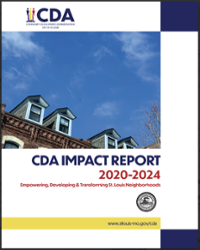CDA Strategy & Vision: Economic Justice & Neighborhood Transformation in St. Louis
CDA plays a critical role in providing subsidies, ensuring that new housing development and rehabilitation efforts are financially feasible.
This article first appeared in the CDA 202-2024 Impact Report (April 2025), a comprehensive look at five years of housing, community development, and neighborhood revitalization efforts in St. Louis. To learn more about CDA’s programs, investments, and impact citywide, read the full report here.
Econmic Justice
Generations of racial segregation, restrictive covenants, redlining, and discriminatory appraisal practices have left scars like the Delmar Divide, collapsed homes, and vacant lots etched into the fabric of St. Louis.
Healing these scars is a precondition to our city’s long-term growth. As one study found, “looking at 184 metropolitan areas between 1990 and 2011, we find that the single largest factor that seems to curtail job growth is initial inequality; not far behind in their impact are racial segregation and metropolitan fragmentation.” Equity, Growth & Community, Benner & Pastor.
Today, the City’s development agencies recognize that reversing generations of public disinvestment is not just a moral obligation, but an economic imperative, and that our city cannot grow as long as half of it is left behind.
St. Louis’ Economic Justice Action Plan (EJAP), developed to address these structural barriers, outlines intentional strategies to heal the scars of segregation and foster inclusive economic development. One of the EJAP’s key insights is that investing in people—not just the built environment—is the key to ensuring sustainable growth and lasting neighborhood transformation.
One tool, which we have developed to support this work, is the Economic Justice Index (EJI, see QR code on this page), which tracks a wide range of socioeconomic factors including Life Expectancy, Violent Crime Rates, Income, Property Values, Vacancy Rates, Educational Outcomes, Internet Access, Demographics, and more in order to identify neighborhoods with the greatest need. As you can see by comparing the EJI with the Neighborhood Transformation Investments map, CDA’s investments reflect EJI priorities.
In 2022, the City issued anARPA Needs Survey, which received nearly 5,000 responses. Across racial, gender, age, and socioeconomic groups, a majority of city residents identified “Neighborhood Transformation” as their top priority. Neighborhood Transformation means:
- Rehabilitating historic buildings and giving them new life.
- Transforming vacant land from a liability into an asset through strategic redevelopment and green infrastructure.
- Investing in safe streets, transit, grocery stores, health clinics, daycares, small businesses and community gardens.
- Fostering mixed-income, diverse and vibrant communities that promote stability and opportunity.
St. Louis’ long-term population decline presents serious development challenges, reducing the City's ability to attract investment and sustain economic growth. Many neighborhoods have struggled with disinvestment for decades, with some areas not seeing a single new mortgage originate in over 30 years. In these cases, CDA’s role is to help "make a market"—providing the initial investment necessary to stimulate private development. Historic examples like Fox Park, which was in decline but saw revitalization due to targeted investments in the 1990s and 2000s, demonstrate how public funding can lay the foundation for long-term market stability. More recently, the West End is showing similar signs of growth due to strategic CDA-supported housing production.
Building in St. Louis presents unique challenges. Years of population loss and vacancy have created obstacles such as buried building remnants, brownfields, and deteriorating infrastructure. A certain level of subsidy is needed in most neighborhoods to overcome these barriers and attract private investment. CDA plays a critical role in providing those subsidies, ensuring that new housing development and rehabilitation efforts are financially feasible and that historically disinvested neighborhoods receive the support they need to grow.
About the Community Development Administration (CDA):
Established in 1974, CDA invests approximately $25 million each year in affordable housing, community development, and public services across St. Louis. As the City’s housing and community development agency, CDA works in partnership with HUD, the Planning and Urban Design Agency, and the St. Louis Development Corporation to ensure that funding priorities are transparent, competitive, and community-driven.
-
Contact Information:
Tom Nagel
Public Information Officer II -
Department:
Community Development Administration
-
Topic:
Community
History and Heritage
Government
Related Stories
Help Us Improve This Page
Did you notice an error? Is there information that you expected to find on this page, but didn't? Let us know below, and we'll work on it.
Feedback is anonymous.
